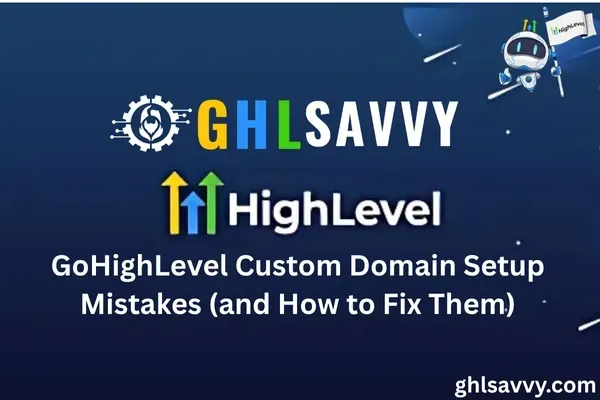
GoHighLevel Custom Domain Setup Mistakes (and How to Fix Them)
Introduction:
One of the first big steps in building your GoHighLevel ecosystem is setting up a custom domain. A GHL custom domain makes your agency, SaaS platform, or client projects look professional while keeping your brand front and center.
But here’s the problem most users trip over domain setup. Small mistakes can lead to broken funnels, email deliverability issues, and frustrated clients. And if you’re running SaaS mode setup GoHighLevel, these mistakes can cost you serious revenue.
In this guide, we’ll cover the most common GHL custom domain setup mistakes and how to fix them fast. Whether you’re a beginner or scaling with Gohighlevel Mastery, this resource will help you avoid roadblocks and confidently set up your custom domain.
Why Custom Domains Matter in GoHighLevel
Before diving into mistakes, let’s address why custom domains are critical.
Professional branding – No one wants their funnels or courses on a “myagency.mygohighlevel.com” subdomain.
Client trust – A custom domain reassures clients and students that they’re in the right place.
Email deliverability – Setting up proper DNS records ensures emails don’t land in spam.
Scaling SaaS mode – If you’re offering white-label SaaS, domains are non-negotiable.
In short, your domain setup isn’t just technical it’s foundational to your success.
The Top GHL Custom Domain Setup Mistakes (and Fixes)
Here are the most common pitfalls we see agencies and course creators make when setting up their domain inside GoHighLevel.
1. Forgetting to Update DNS Records
The Mistake:
Users often forget to update DNS records (A, CNAME, TXT) at their domain registrar. Without these, your domain won’t point to the right servers.
The Fix:
Log in to your registrar (GoDaddy, Namecheap, Cloudflare, etc.).
Add the correct CNAME pointing to GoHighLevel.
Add TXT records for email verification.
Verify propagation using tools like DNSChecker.
👉 Pro tip: If you’re in SaaS mode setup GoHighLevel, double-check DNS entries for every client to avoid subdomain conflicts.
2. Mixing WWW and Non-WWW Versions
The Mistake:
Some users configure “www.domain.com” but forget “domain.com” (or vice versa). This causes redirection loops or site errors.
The Fix:
Always choose one canonical version (www or non-www).
Set up 301 redirects to avoid duplicate content.
Test both versions after setup to ensure consistency.
3. Skipping SSL (HTTPS) Configuration
The Mistake:
Launching without SSL. Students or clients see scary browser warnings like “Not Secure”.
The Fix:
Enable the free SSL certificate in GoHighLevel.
Check that HTTPS forces correctly on all pages.
Renew certificates automatically.
SSL isn’t optional it’s required for trust, SEO, and payments.
4. Using Email Without Proper Authentication
The Mistake:
Sending emails from your domain without setting SPF, DKIM, and DMARC records. This leads to poor deliverability and spam flags.
The Fix:
Add SPF and DKIM TXT records provided by your email provider (Google Workspace, Outlook, etc.).
Set up DMARC for reporting.
Test using tools like MailTester.
When running Gohighlevelcourses or automations, your emails must land in inboxes—not spam folders.
5. Not White-Labeling in SaaS Mode
The Mistake:
Agencies forget to set up domains in SaaS mode setup GoHighLevel, leaving GoHighLevel branding exposed.
The Fix:
Assign custom subdomains for each client.
Add their branding, SSL, and white-label login URLs.
Use GoHighLevel Masterclass training to streamline SaaS domain setup.
This small step makes your agency look like a true software provider.
6. Overlooking Subdomain Strategy
The Mistake:
Agencies randomly assign subdomains (like “client1.youragency.com”), making things messy.
The Fix:
Plan subdomain structures:
portal.clientname.com,courses.youragency.com,crm.client.com.Keep naming conventions consistent.
Avoid using the same subdomain twice.
7. Not Testing After Setup
The Mistake:
Assuming everything works after updating DNS. Students can’t access courses, or funnels break.
The Fix:
Test URLs in multiple browsers.
Use incognito mode to clear cache issues.
Verify email links point to the correct domain.
Advanced Tips for Flawless GHL Domain Setup
If you’re scaling with Gohighlevel Mastery or handling multiple clients, you’ll want to go beyond the basics.
Use Cloudflare for DNS management – Faster propagation and extra security.
Automate SSL renewals – Save headaches down the line.
Monitor DNS health – Services like UptimeRobot alert you if domains break.
Create a domain checklist – Standardize setup across all projects.
How Domain Setup Impacts SaaS Growth
For agencies running SaaS mode setup GoHighLevel, domain mistakes can stall growth:
Clients may lose trust if login pages don’t match their brand.
Broken subdomains = lost leads.
Poor email deliverability kills client campaigns.
That’s why investing in proper Gohighlevel Training is essential. Learning the ins and outs of domain setup prevents costly errors as you scale.
Learning Resources: Master Domain Setup
Want to master domain setup (and more) in GoHighLevel? Here are two trusted resources:
GoHighLevel Masterclass – Deep-dive courses covering domains, funnels, automations, and SaaS mode.
GHL Savvy – Guides, audits, and resources for agencies scaling with GHL.
Between these, you’ll move from guessing to confidently executing.
Final Thoughts
A GHL custom domain isn’t just a technical detail it’s the backbone of your agency or course business. Done wrong, it creates broken funnels, spammy emails, and frustrated clients. Done right, it builds trust, improves deliverability, and helps you scale in SaaS mode setup GoHighLevel.
If you’re serious about growth, avoid the mistakes outlined here, follow best practices, and invest in Gohighlevel Mastery through resources like GoHighLevel Masterclass. With the right training and attention to detail, your domains will be bulletproof, and your agency will be positioned as a professional, scalable SaaS powerhouse.